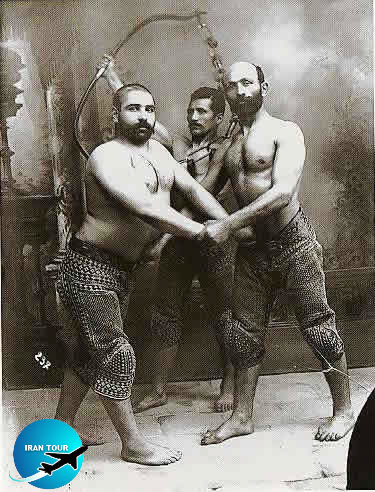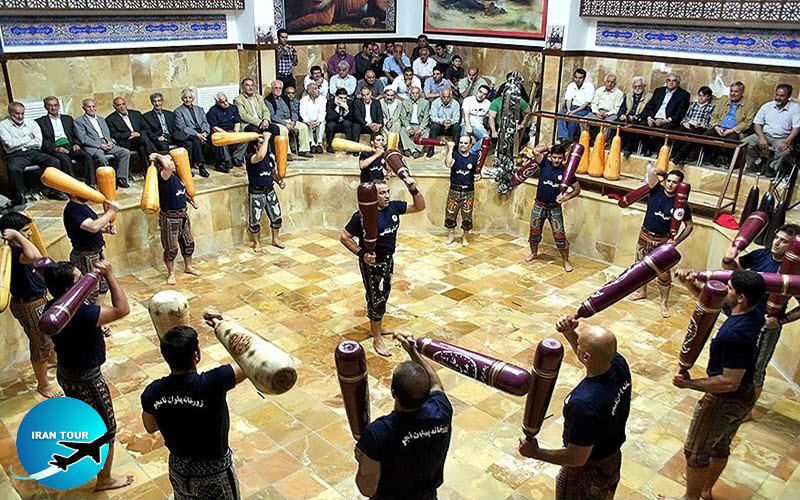Copyright 2020 - 2021 irantour.tours all right reserved
Designed by Behsazanhost
Zour Khaneh
Zour Khaneh
A Scene of Manliness, Excellence, and Humanistic Unity
Talking about an ancient sport, Varzesh-e-Bastani' which is still practiced in such metropolitan cities as Esfahan, Tehran, Shiraz, Yazd, and Qom, and ... is evocative. The sport can be regarded as a kind of traditional gymnastics holds in Zour Khaneh (house of strength) and the sportsmen are called; Bastanikar. In ancient eras, during the Achaemenid, swift young men found the opportunity to be trained physically for the techniques and knacks of fighting in some private gymnasiums in which accounted as types of schools for hardworking and strengthening. This way of strengthening continued during the time of the Sassanian Dynasty. After the advent of Islam, especially during the Safavid period, and the proclamation of Shi’ism as a religious doctrine, an athlete (Bastanikar) was considered a national and religious hero. Basically, the training of strongmen with religious beliefs was one of the necessities of that society. So, gradually the number of Zour Khanehs increased, and the breathless exercises changed into more proper ones. At the same time, the developing tactics of the sport are integrated as a part of the cultural aspects of Iranian life.
 |
In the middle of Zour Khaneh, there is a deep octagonal space in which the sport is practiced, and each time a group of athletes attends (maximums of 20 people depending on its capacity) meeting with a kind of spirit saturated with manliness, purity, and a physically muscular body who are called; Pahlavan, a paragon of morality and strength. They exercise in absolute harmony with the rhythms, prayers, and poems of the mentor called; Morshed (the manager, drummer, and reciter) as he sits and rings a bell each time to increase the eagerness, pleasure, dynamism, harmony, and unity to create a synergetic atmosphere. The sport, from the beginning to the end is conducted by Morshed who also recites some epic verses and keeps the sportsmen swiftly active all the time. According to one of Saadi's poems ( 13th century ), a mentor always starts his sermon about mankind by these concepts:
In the following, some of the normal rounds are briefly reviewed. It starts with the name of God and commemorations of the greatness and virility of Emam Ali (a.s.), the first unique hero after the advent of Islam.
 |
Then, a stressful round for strengthening muscles called Shena by bending on a two-legged board and leaning on arms, with twisting and torsion to the left and right moving back and forth, starts upon the movements of the person in the middle which is called; Miandar as the master. In this stage, lots of stress is imposed on the muscles that cause contraction, thus the next stage is based on some relaxation by light movements to stretch the muscles.
The next round begins with moving Sang, which is a pair of heavy wooden hields, ranging between 40 to 70 kilograms. During this round, Morshed recites more epic verses. The heavy wooden shields are simulated forms of real shields on a battlefield Then, the other stages continue in an atmosphere of national and religious traditions, specific rhythms are notable in a state of purity, respect, and humility in a special manner. Some other exercises start with a simulated model of mace made of heavy wooden pieces called; Mill and a kind of steel arch with a heavy chain as a simulated form of bow and arrow named; Kabadeh, as well as Charkh, which is a fast-spinning movement while arms are outstretched in order to get ready against dizziness for opening the queues of the enemies in a battlefield, by holding two swords or maces in hands, while moving back and forth. Each of these exercises normally causes one to become breathless.
 |
The heroes kiss the floor of the octagon at the beginning, as a symbol of modesty indicative of ashes to ashes, dust to dust. During an individual's performance, each one gets permission from the others to show his humility and priority of the others to himself. The younger persons, Nowcheh (novices) show lots of respect to the older ones, and sometimes four successive generations at the same site exercising harmoniously with the same group, are in a framework of the sport which strengthens the bodies and minds of the athletes and simultaneously presents some practical patterns of manliness and good temperament to people.
- Details
- Category: IRAN Blog